 Date: Thursday, March 4 Date: Thursday, March 4
Time: 8:00
Admission: $5.00
“Death Become Them, Unearthing the Suicides of the Brilliant, the Famous, and the Notorious,” journalist/author Alix Strauss will discuss in an illustrated lecture based on her research for her book “Death Becomes Them,” the phenomenon and history of suicide and the seductive appeal of celebrity suicide in Western culture. Over the course of her lecture, she will present fascinating details leading up to the last days of icons of celebrity suicide such as Virginia Woolf, Sigmund Freud, Spalding Gray, Kurt Cobain, Diane Arbus, and Vincent van Gogh. After reading from selected passages, she will discuss the methodology, pathology, and psychology of these luminaries, with an eye towards understanding why such brilliant people all chose this particular end. She will also touch on society’s needs to “mass mourn,” the cultural phenomenon of funerals, and the role that mental illness and addiction play in suicide.
Along with the reading and lecture, Alix will also do a quiz, complete with prizes. Specially packaged copies of “Death Become Them,” which come with a Quija Board Key chain or a Happy Childhood Memories Spay, will be available for purchasing and signing. Those who buy copies will also get a special gift — a small bottle of Funeral Home perfume, a coffin filled with skeleton mints or a waterproof mascara.
Alix Strauss is author of Death Become Them: Unearthing the Suicides of the Brilliant, the Famous, and the Notorious.” She also a media savvy social satirist, and featured lifestyle and trend writer. She is the author of the award winning short story collection, The Joy of Funerals (St. Martin’s Press), and the forthcoming novel, Based Upon Availability, June of 2010 (Harper Collins).
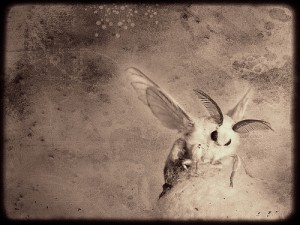 Date: Saturday, April 3, 2010 Date: Saturday, April 3, 2010
Time: 8:00
Admission: $5.00
Observatory presents a an illustrated lecture with Shanna Maurizi, contributing artist to the current Observatory show Entomologia.
Silkworms engineered to produce pharmaceuticals and hormones, cyborg dragonflies designed for high-speed missions and surveillance…
In connection with her recent work, Shanna Maurizi has been delving into the nether regions of genetic engineering and transgenics, molecular biology, and military cybernetics.
Hovering on the edge of the known, and obscured from view as a result of political and capitalist agendas, new life forms are being created which prompt a mixture of wonder and horror. In addition, controversial new research in genetics is challenging the traditional gene-based model of heredity, suggesting non-DNA based transmission systems and exposing the gaps in our understanding of the natural world. RNA and chromatin, transposons and species jumping, DARPA’s HI-MEMS project and the transformations of Bombyx Mori; Ms. Maurizi charts a path through these topics, uncovering evocative connections and perplexing possibilities along the way.
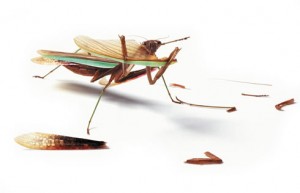 Date: Friday, March 12 Date: Friday, March 12
Time: 7:30
Admission: $5.00
Observatory presents a short film screening and talk with Catherine Chalmers, contributing artist to the current Observatory show Entomologia.
From an interview with Chalmers in Aperture, “Insects are a window into the unimaginable. Their biology and behaviors are routinely bizarre and enigmatic to us – they are refreshingly outside the human perspective. I think that our experience can be enhanced by an attempt to understand and give meaning to other life forms.”
Join us for a screening of Catherine Chalmer’s film, Safari, grand jury winner at SXSW in 2008.
“‘Safari’ is an evolutionary melodrama. Here the cockroach emerges from the primordial sea, crawling on land for the first time. Then, navigating the lush, verdant jungle alongside Chalmers’ ground-hugging camera, the cockroach encounters oversized insects, amphibians, and reptiles. When two gigantic rhinoceros beetles lock horns in aggressive combat, it is like 1950s sci-fi movies in which irradiated insects rule the earth. Yet this intimate vantage point also magnifies the striking physical beauty of these tiny creatures, inviting an appreciative reappraisal of numerous species we typically overlook or devalue as mere pests.” (Quote from SXSW)
The screening will be followed by a talk about the cast of the Safari; 20 species of insects, reptiles and amphibians she raised in her SOHO studio.
Chalmers will also screen her newest film, We Rule, focused on the incredible leaf cutter ant and filmed on location in Costa Rica.
 Date: Friday, April 2nd Date: Friday, April 2nd
Time: 8pm
Admission: $5
Phantasmaphile presents this illustrated exploration of geometry with Martin Bland
In his words:
“The beauty of Geometry often defines the framework of the physical world about us. Objects we handle everyday are comprised of the same repeated ratios and their reciprocals. For example, the apple shown here, when cut in half horizontally, exhibits the Golden Section not only in its pentagonal structure but is also approximated (and even I was surprised to find this) in its growth ratio.
This talk will cover Number and its significance in the ancient world to the present day; Form, wedded to number through the first eleven polygons and their interrelationships; and further, Application, how one may use this information to comprehend and construct space and the objects contained within.
All simplified in an easy to understand form (no higher math is required), this talk is a general introduction into geometry using ancient methods and forms. Marshalling the power of these forms is possible for anyone, one must simply know where and how to go about looking. Although geometric constructions will be shown, the audience will not be “asked to approach the blackboard,” but rather to enjoy some of the author’s curious discoveries along his path towards creating his recent publication.
Though Post-Modernism seems to have failed us, the syncretic tradition is alive and well, as it always has been. The need to focus on what we find in common across various cultural traditions is more important today than ever. Geometry is the closest thing to a universal language that exists and its study as part of a syncretic tradition can be most useful in understanding the world of symbology that we find ourselves immersed in each day.”
About Martin Bland
Martin Bland is an artist who lives and works in New York. In April of 2009 he traveled to the Alhambra in Granada Spain to study geometry with Keith Critchlow. He recently published Useful: a step by step guide to the understanding of generative number in form (Pataphysical Longing Productions 2009) in which a series of polygons unfold, step-by-step, in a single diagram without the hindrance of text as is customary with such works. It is the only book of its kind in publication making it a valuable resource for any library. www.martinbland.com
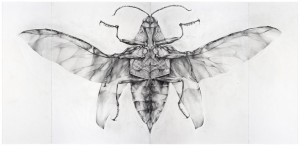 - Joianne Bittle, Jewel Beetle (ventral view), 2007 graphite on paper 44 x 90.5 inches
Date: March 19, 2010
Time: 8:00
Admission: $5.00
Curious Expeditions and Observatory present a talk of insects, world travel, and art with Joianne Bittle, contributing artist to the current Observatory show Entomologia, and diorama artist for the American Museum of Natural History.
Artist Joianne Bittle will discuss her series of beetle paintings, A Royal Family, as well as her large, four-paneled graphite drawing of the jewel beetle from Southeast Asia. These works are the result of six years of observing, from life, four different types of beetle specimens. Watch an image timeline of diorama projects she has completed at the American Museum of Natural History and learn about the naturalists and scientists at the Museum who have inspired her work. In addition, Bittle will discuss influential artists, her travels around the world as well as her current paintings and drawings of the black-tailed jackrabbit and its harsh environment, the desert.
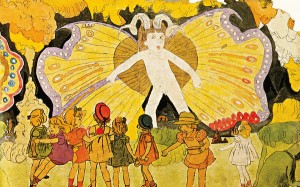 Morbid Anatomy Presents Morbid Anatomy PresentsAn illustrated lecture by Jaimy Mann,
2009 Henry Darger Study Center Research Fellow
Friday, February 5th
8:00 PM
$5
Outsider artist Henry Darger (1892-1973) is commonly remembered as a reclusive janitor who spent his life secretly creating a richly realized, bizarre and perverse fantasy world discovered only upon his death. While most who have considered Darger have seen his work as a spontaneous act of solitary and warped imagination, in tonight’s lecture, Darger scholar Jaimy Mann will reexamine the accepted narrative by discussing Darger’s work within the larger context of American cultural history and Darger’s personal biography. She will also introduce us to the holdings of the Henry Darger Archive held by the American Folk Art Museum in New York — where she conducted research as the 2009 Henry Darger Study Center Research Fellow — and give advice on how interested parties can gain access.
Contrary to popularly held beliefs, Henry Darger’s work-Mann argues- was not created in the vacuum of one cloistered man’s mind. While many of his paintings depict naked and brutalized child slaves and transexual transformation, L. Frank Baum’s phenomenally popular Oz books-which Darger read and collected- explored many similar topics normally taboo in the mainstream of American culture. “In the Realms of the Unreal,” Darger’s 15,000 page epic, draws from and inter-textualizes Oz, as well as the larger cultural obsessions with white slavery, seen, for example, in the passage of the “White Slave Traffic Act” in 1910. Further, Darger was personally affected by the instability and vulnerability that marks the existence of displaced children. When his mother died in childbirth, his baby sister was put up for adoption, and while in the home for feeble-minded children, Darger himself was almost adopted. He also desperately worked to adopt a child for decades as an adult, and in the archive, Mann investigated some rarely-exhibited collages (which will be on view at the American Folk Art Museum in 2010) that make use of photographs of Korean and Vietnamese children culled from newspapers. When looked at in this larger context of American cultural history, Mann believes that Darger is a key figure for understanding the notion and draw of “cuteness” in the United States, and will discuss how this notion is united with violence, race, and adoption.
Jaimy Mann is a Ph.D. candidate at the University of Florida, specializing in Children’s Literature and Culture and Gender Studies. She is based in Los Angeles, where she is raising her two-year-old daughter Querelle Magdalena while completing her dissertation “The Transnational Transracial Politics of Cute and Kawaii.” She was the 2009 Henry Darger Study Center Research Fellowship at the American Folk Art Museum in New York, where she had unlimited access to Darger’s books, paintings, and personal collection of newspaper clippings, collages, letters, religious items, and various other ephemera, which are housed in the museum archive. For more, please see http://jaimym.pixelfix.com/
 An illustrated lecture and book signing by Lisa Rosner, Professor of History at Richard Stockton College of New Jersey. An illustrated lecture and book signing by Lisa Rosner, Professor of History at Richard Stockton College of New Jersey.
Date: Thursday, March 18th
Time: 8:00 PM
Admission: $5
Presented by Morbid Anatomy
Up the close and down the stair,
But and Ben with Burke and Hare.
Burke’s the butcher, Hare’s the thief,
Knox the man who buys the beef.
—anonymous street song
On March 18, 2010, Lisa Rosner will be discussing the myths and realities of the Burke and Hare case, resurrected in her recent book The Anatomy Murders: Being the True and Spectacular History of Edinburgh’s Notorious Burke and Hare and of the Man of Science Who Abetted Them in the Commission of Their Most Heinous Crimes.
On Halloween night 1828, in the West Port district, a woman sometimes known as Madgy Docherty was last seen in the company of William Burke and William Hare. Days later, police discovered her remains in the surgery of the prominent anatomist Dr. Robert Knox. Docherty was the final victim of the most atrocious murder spree of the century, outflanking even Jack the Ripper’s. Together with their accomplices, Burke and Hare were accused of killing sixteen people over the course of twelve months in order to sell their corpses as “subjects” for dissection. The ensuing criminal investigation raised troubling questions about the common practices by which medical men obtained cadavers, the lives of the poor in Edinburgh’s back alleys, and the ability of the police to protect the public from cold-blooded murder.
Lisa Rosner is Professor of History at Richard Stockton College of New Jersey. She received her AB from Princeton University and her PhD from Johns Hopkins University. She has been awarded fellowships from the American Philosophical Society, the National Endowment of the Humanities, the Chemical Heritage Foundation, and the New Jersey Historical Commission. The Anatomy Murders is the third book in her historical trilogy on Edinburgh medicine. The Worlds of Burke and Hare, the companion website to The Anatomy Murders, is available at Burke and Hare.
Image used by permission of the Library of the Royal College of Physicians of Edinburgh.
 A Documentary about Outsider Artist Renaldo Kuhler A Documentary about Outsider Artist Renaldo Kuhler
Date: Friday, February 19th
Time: 8pm
Admission: $5
Rocaterrania is a feature length documentary exploring the secret world of scientific illustrator and visionary artist Renaldo Kuhler. This screening is presented by Phantasmaphile.
In the last four decades, seventy-six-year-old Renaldo Kuhler has created hundreds of plates for the North Carolina Museum of Natural Sciences, illustrating diverse flora and fauna for obscure scientific journals and reference books. Before the making of this documentary, no one knew that Kuhler is also a prolific visionary artist - and the creator of an entire imaginary world called Rocaterrania.
Rocaterrania is a tiny nation of eastern European immigrants who purchased a tract of land along the Canadian border - just north of the Adirondack Mountains in New York - after growing restless with America’s notions of “democracy.” Over the next six decades, Rocaterrania saw two revolutions and the rise and fall of a succession of czars, dictators, and presidents among a cast of characters vaguely resembling Russian historical figures. But, as the film reveals, each change in government reflects a deeper meaning for Renaldo, an outsider who struggled to escape an emotionally abusive family and searched for freedom within a real nation threatened by forces of conformity.
Rocaterrania unveils Kuhler’s astounding body of work to the world and reveals the powerful story of his life in the process. Among other themes, the film is about the insidious nature of conformity, the courage to be one’s true self, and the redemptive power of artistic creation. Featuring an eclectic original score by Merge Records recording artists Shark Quest.
Rocaterrania is directed by Brett Ingram and released by Bright Eye Pictures.
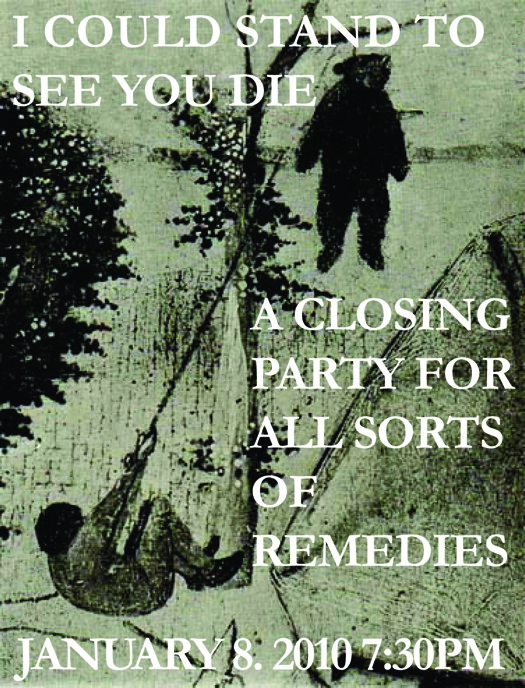
Date: Friday, January 8
Time: 7:30
Admission: Free
A closing Party for ALL SORTS OF REMEDIES.
Get drunk and say good-bye.
With C&W weepers from the golden age as backdrop.
And featuring a performance by PERFVGIVM.
NOTE: ALL SORTS OF REMEDIES has been extended, and will now be closing on Sunday, January 10th.
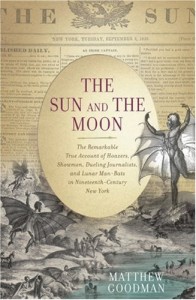
Date: Friday, January 29
Time: 7:30
Admission: $5.00
Curious Expeditions and Observatory proudly present:
In the summer of 1835, a series of articles in the penny newspaper the New York Sun convinced most of New York that life, including such marvelous creatures as unicorns and man-bats, had been discovered on the moon. It was the most sensational — and successful — hoax in the history of newspapers.
Join author Matthew Goodman as he discusses his book The Sun and the Moon: The Remarkable True Account of Hoaxers, Showmen, Dueling Journalists, and Lunar Man-Bats in Nineteenth-Century New York. It’s the stranger-than-fiction story that the Los Angeles Times called “a delightful history,” the Wall Street Journal called “a ripping good newspaper yarn,” and the Economist Magazine named as one of the Best Books of 2008. In his talk, Matthew will discuss what New York was like in the 1830s, the birth and growth of the New York newspaper industry, and reveal how (and why) the ”Great Moon Hoax” was perpetrated, how such larger-than-life characters as P.T. Barnum and Edgar Allan Poe were involved with it, and what it all has to do with the conflict between science and religion in the nineteenth century.
A book signing with the author will follow the event.
|
 Date: Thursday, March 4
Date: Thursday, March 4

 Date: Friday, April 2nd
Date: Friday, April 2nd
 Morbid Anatomy Presents
Morbid Anatomy Presents


